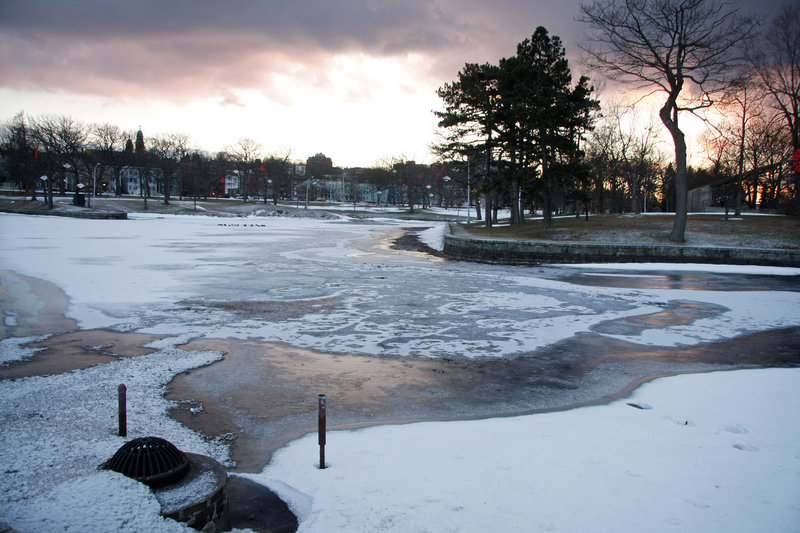PORTLAND – A plan to cover the sandy bottom of the Deering Oaks duck pond with concrete could improve water quality in the pond, which has become choked with muck and algae in recent years.
City spokeswoman Nicole Clegg said the concrete bottom would cost about $1.2 million, with more than half of it — $660,000 — federal money secured by U.S. Sen. Susan Collins, R-Maine.
The rest would come from the city, which would probably allocate money from the next annual capital improvement budget, with the work to be done in 2012. The project also would involve shoring up the rock wall that surrounds the pond, Clegg said.
Water quality in the pond has been a problem for years, said Anne Pringle, president of Friends of Deering Oaks, a park advocacy group.
In the summer, the unsightly algae “becomes so thick, it looks as if you could walk across the water on it,” she said.
In the winter, the poor water quality and fallen leaves that rise to the surface create uneven ice that’s not great for skating, Pringle said.
Clegg said the water quality issue stems from several sources, including a combined sewer overflow that sent untreated wastewater into the pond when heavy rain overwhelmed storm sewers in the area.
That problem has been addressed in the past couple of years by the separation of storm and wastewater sewers, but the pond is also harmed by leaves piling up in the water during the fall.
That promotes algae growth, which makes it hard for city crews to remove trash from the pond, Clegg and Pringle said.
Clegg said the muck is rarely cleaned out, even though the pond is drained in the spring and fall, because it’s a costly, labor-intensive job.
Because of the soft bottom, she said, heavy equipment can’t be used. A cleanup in early December — the first in two decades — had to be done manually, which takes more time and is more expensive.
The cleanup took about three weeks, and even that wasn’t enough time to do the job thoroughly, Clegg said.
It cost the city about $19,000 for labor — paying city workers — and about $130,000 to truck and dispose of tons of waste cleaned from the pond.
With concrete on the bottom on the pond, she said, heavy equipment could be used and the cleanup could be done with street sweepers, probably in less than a workweek.
The concrete bottom also would cut off the flow of several springs in the pond that cause uneven ice thicknesses. Small plows that the city uses to clear snow from the ice occasionally fall through when they go across thin spots, Clegg said, and the springs are a likely culprit.
Clegg said the long-range plan calls for underground basins to hold storm surges that now can send brackish water from Back Cove through a pipe that connects it with the pond. That would eliminate another cause of thin ice spots, she said.
Clegg said the pond is “an important part of our community” and needs to be maintained.
Pringle echoed that sentiment and noted that the city has done a good job of repairing and maintaining the park since her group was formed more than 30 years ago. The city adopted a master plan for improvements, she said, and has continued to chip away at the list of jobs, with the pond project the next one.
“It’s a difficult time to make capital improvements,” she said, but the city must take advantage of the chance to have part of the cost paid by the federal government, which would allocate the money under a clean water program run by the Environmental Protection Agency.
Pringle said that once the pond is cleaned up, it can be more of a resource for community recreation. She said hobbyists could run radio-controlled boats on the pond, and the popular paddle boats could make a return.
Staff Writer Edward D. Murphy can be contacted at 791-6465 or at:
emurphy@pressherald.com
Send questions/comments to the editors.




Success. Please wait for the page to reload. If the page does not reload within 5 seconds, please refresh the page.
Enter your email and password to access comments.
Hi, to comment on stories you must . This profile is in addition to your subscription and website login.
Already have a commenting profile? .
Invalid username/password.
Please check your email to confirm and complete your registration.
Only subscribers are eligible to post comments. Please subscribe or login first for digital access. Here’s why.
Use the form below to reset your password. When you've submitted your account email, we will send an email with a reset code.